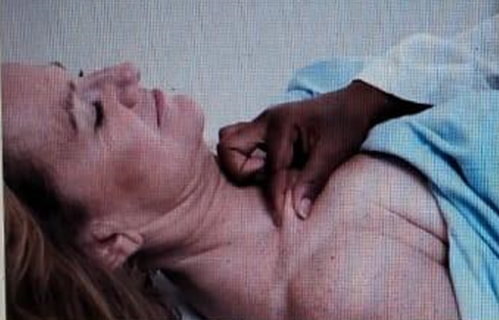The nurse performs the action shown in this image during the assessment of a client. What is the nurse assessing?

Intercostal spaces
Lymph nodes
Skin Turgor
Carotid Pulse
The Correct Answer is C
A) Intercostal spaces:
Assessing intercostal spaces typically involves palpating or inspecting the area between the ribs to check for abnormalities such as retractions or tenderness, usually conducted with the client sitting or standing.
B) Lymph nodes:
Palpation of lymph nodes, such as in the cervical region, involves using fingertips to gently feel for enlarged or tender nodes. This examination focuses on areas like the neck, underarms, and groin.
C) Skin Turgor:
The image depicts a nurse pinching the skin, likely on the chest or forearm, which is a common method to assess skin turgor. Skin turgor evaluation helps determine hydration status; if the skin remains tented and returns slowly to its original position, it indicates dehydration.
D) Carotid Pulse:
Assessing the carotid pulse involves palpating the carotid artery along the side of the neck to evaluate the strength and rhythm of the pulse. This is typically done using the pads of the fingers, not by pinching the skin.
Nursing Test Bank
Naxlex Comprehensive Predictor Exams
Related Questions
Correct Answer is B
Explanation
(a) Soles of the feet:
The soles of the feet are not considered the most reliable indicator of central cyanosis because peripheral areas can be affected by various factors, including temperature and circulation. Changes in color here might not accurately reflect central oxygenation status.
(b) Oral mucosa:
The oral mucosa is the most reliable indicator of central cyanosis because it reflects the oxygenation status of the central circulatory system. Cyanosis in this area indicates a significant drop in arterial oxygen saturation and is a more direct indicator of hypoxemia compared to peripheral sites.
(c) Ear lobes:
Ear lobes, like the soles of the feet, can be influenced by peripheral circulation and environmental factors. While cyanosis can be observed here, it is not as reliable as central sites like the oral mucosa for assessing systemic oxygenation.
(d) Conjunctivae:
The conjunctivae can show signs of cyanosis, but the oral mucosa is still a more sensitive and reliable indicator for central cyanosis. The oral mucosa provides a clear and consistent site to assess oxygenation in emergency situations.
Correct Answer is C
Explanation
A) Snellen chart:
The Snellen chart is used to assess distance vision, not near vision. It consists of letters or symbols arranged in rows, with the client typically asked to read from a specific distance to test visual acuity.
B) Penlight:
A penlight is primarily used to assess pupillary reactions and near vision tasks such as accommodation. It helps examine how the pupils respond to light and how well the eyes focus on near objects.
C) Magazine:
A magazine or similar reading material is commonly used to assess near vision. Clients are asked to read the text at a comfortable distance, evaluating their ability to focus on close-up objects and the clarity of their vision.
D) Ophthalmoscope:
An ophthalmoscope is used to examine the interior structures of the eye, such as the retina and optic nerve head. It is not used for assessing near vision but rather for diagnosing conditions affecting the eye's internal structures.
Whether you are a student looking to ace your exams or a practicing nurse seeking to enhance your expertise , our nursing education contents will empower you with the confidence and competence to make a difference in the lives of patients and become a respected leader in the healthcare field.
Visit Naxlex, invest in your future and unlock endless possibilities with our unparalleled nursing education contents today
Report Wrong Answer on the Current Question
Do you disagree with the answer? If yes, what is your expected answer? Explain.
Kindly be descriptive with the issue you are facing.
